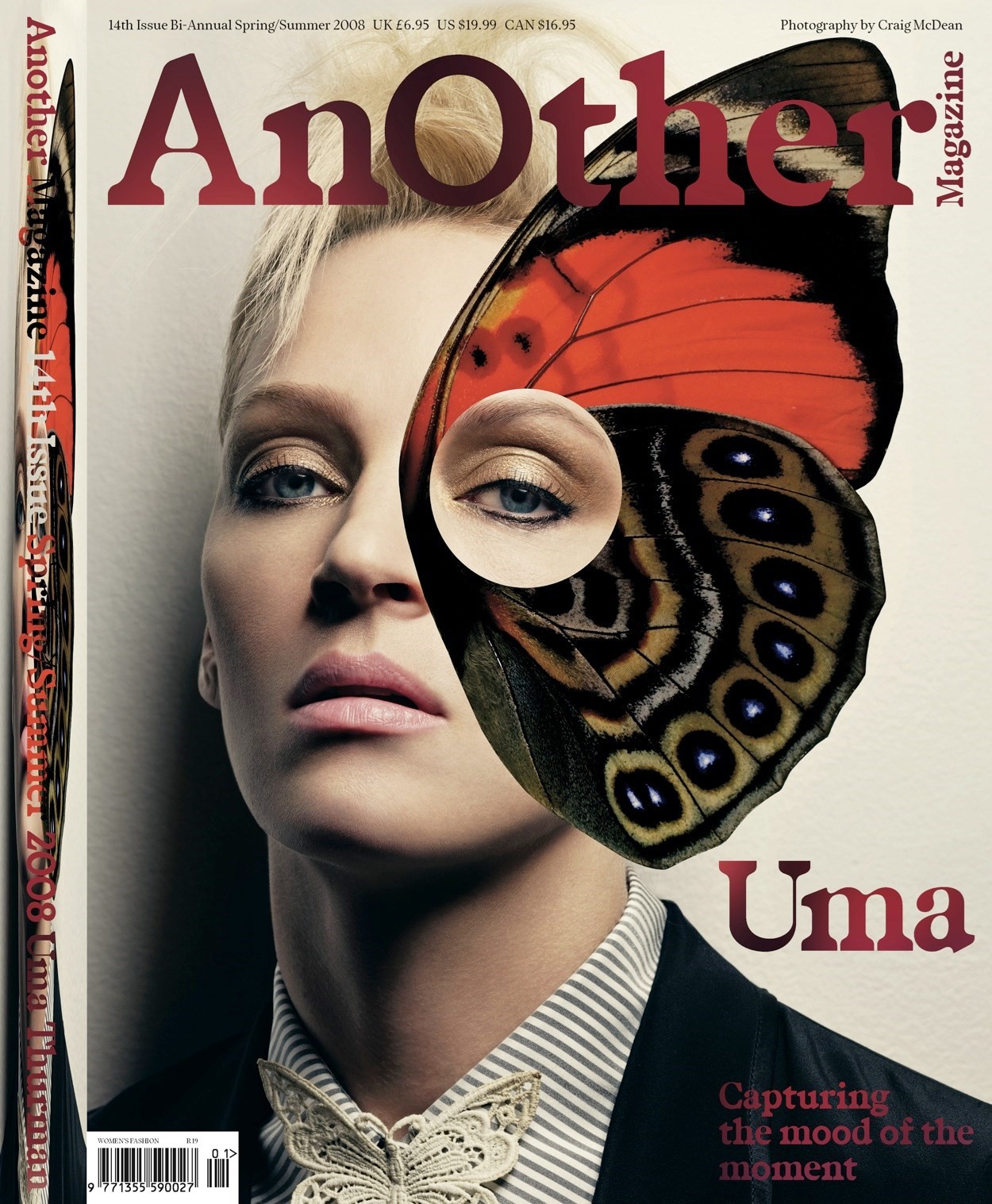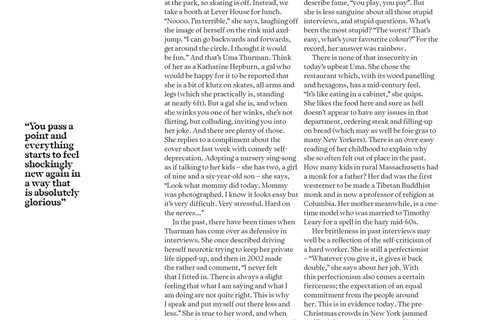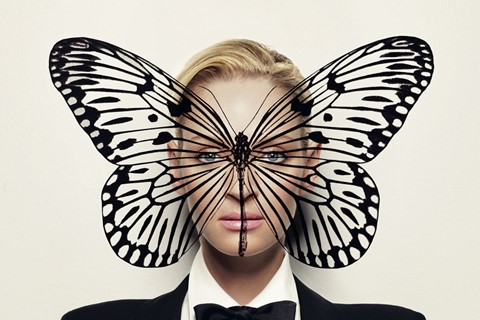Uma Thurman has suggested ice-skating in Central Park for the interview. Ice-skating. With Uma Thurman. The woman who took out the Crazy 88 with a samurai sword. She, who danced the twist at Jack Rabbit Slim’s with John Travolta. OK, so that was the movies, but you can just imagine her response to a tricky question: with a toe-loop and a spin she’s off, gliding away across the ice.
As it turns out, the mid-December crowds are queuing round the block over at the park, so skating is off. Instead, we take a booth at Lever House for lunch. “Noooo. I’m terrible,” she says, laughing off the image of herself on the rink mid axeljump. “I can go backwards and forwards, get around the circle. I thought it would be fun.” And that’s Uma Thurman. Think of her as a Katharine Hepburn, a gal who would be happy for it to be reported that she is a bit of klutz on skates, all arms and legs (which she practically is, standing at nearly six feet). But a gal she is, and when she winks you one of her winks, she’s not flirting, but colluding, inviting you into her joke. And there are plenty of those. She replies to a compliment about the cover shoot last week with comedy selfdeprecation. Adopting a nursery sing-song as if talking to her kids – she has two, a girl of nine and a six-year-old son – she says, “Look what mommy did today. Mommy was photographed. I know it looks easy but it’s very difficult. Very stressful. Hard on the nerves ... ”
In the past, there have been times when Thurman has come over as defensive in interviews. She once described driving herself neurotic trying to keep her private life zipped-up, and then in 2002 made the rather sad comment, “I never felt that I fitted in. There is always a slight feeling that what I am saying and what I am doing are not quite right. This is why I speak and put myself out there less and less.” She is true to her word, and when conversation gets anywhere near personal over lunch she takes the fifth. It can make for a frustrating interview. Ask her which actresses of her generation she admires, and she replies that the more she works, the more she has come to respect them all. Her reticence is fair enough when you consider that even stray comments she has made have been served-up as celebrity news de jour. In 2001, the Oprah-watching world was introduced to the term “body dysmorphic disorder”, after she apparently fretted about her weight in a magazine interview. The everyday anxiety of a new mother was packaged up and sent out there as a full-blown syndrome, even making it into the leader columns of national newspapers. A couple of years later, the gossip rags pecked over the collapse of her marriage to actor Ethan Hawke, the father of her kids. Not that she lets it get to her anymore. She has a nicely Zen phrase to describe fame, “you play, you pay”. But she is less sanguine about all those stupid interviews, and stupid questions. What’s been the most stupid? “The worst? That’s easy, what’s your favourite colour?” For the record, her answer was rainbow.

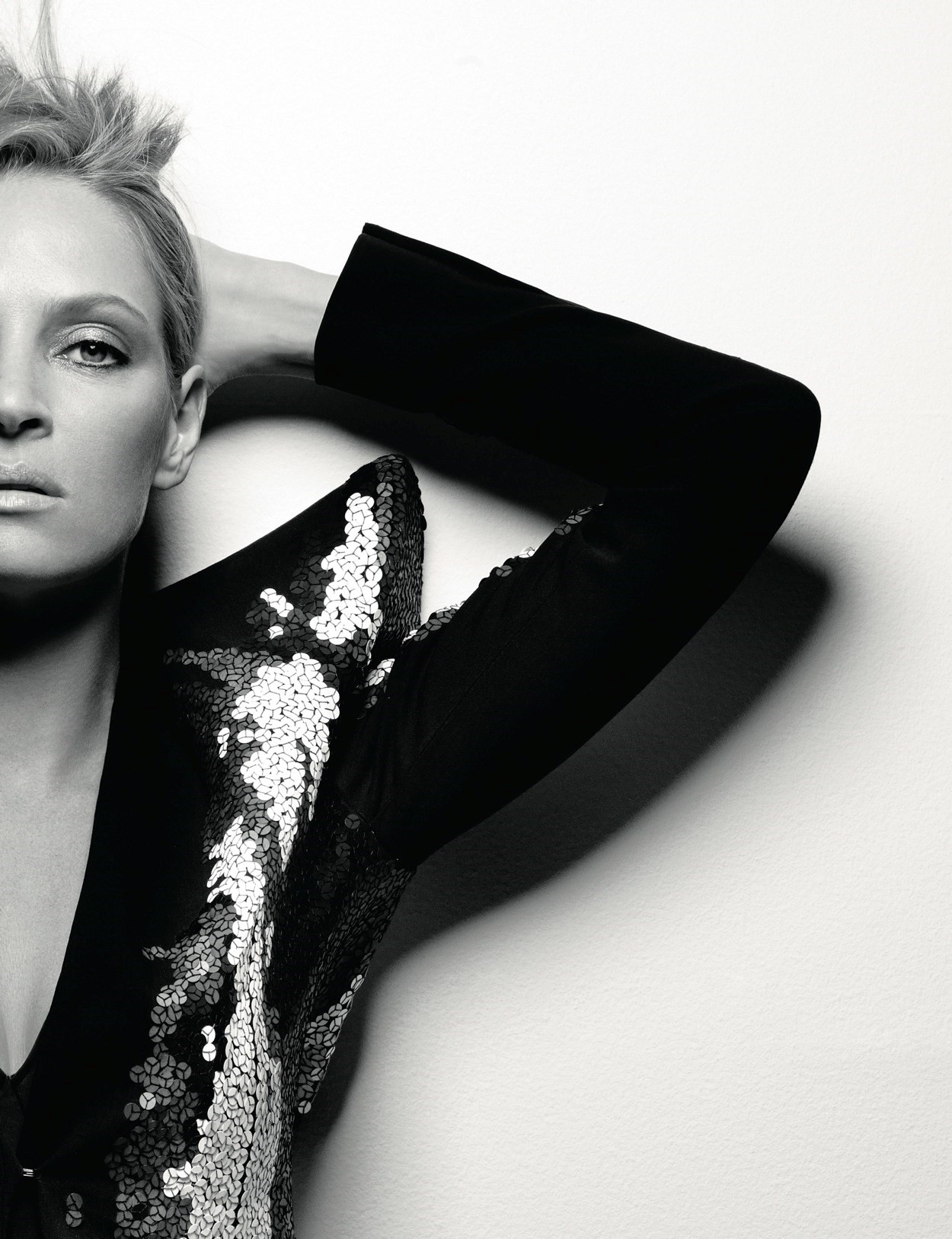
There is none of that insecurity in today’s upbeat Uma. She chose the restaurant which, with its wood panelling and hexagons, has a mid-century feel. “It’s like eating in a cabinet,” she quips. She likes the food here and sure as hell doesn’t appear to have any issues in that department, ordering steak and filling-up on bread (which may as well be foie gras to many New Yorkers). There is an over-easy reading of her childhood to explain why she so often felt out of place in the past. How many kids in rural Massachusetts had a monk for a father? Her dad was the first westerner to be made a Tibetan Buddhist monk and is now a professor of religion at Columbia. Her mother meanwhile, is a onetime model who was married to Timothy Leary for a spell in the hazy mid-60s.
Her brittleness in past interviews may well be a reflection of the self-criticism of a hard worker. She is still a perfectionist – “Whatever you give it, it gives it back double,” she says about her job. With this perfectionism also comes a certain fierceness; the expectation of an equal commitment from the people around her. This is in evidence today. The pre-Christmas crowds in New York jammed traffic right up to midtown, making her late, by a mere and easily-pardonable 15 minutes. Did I get the message? No? Well it ought to have been passed on. Has someone given me copies of her new films The Accidental Husband or The Life Before Her Eyes? Not yet? Well, they should have. If it was Uma Thurman’s job to make either happen, you get the distinct impression these things would have been done.
“You pass a point and everything starts to feel shockingly new again in a way that is absolutely glorious” – Uma Thurman
We saw just how committed Thurman is to her work a few years ago in Quentin Tarantino’s Kill Bill. If she is a Katharine Hepburn, never happier than verbal fencing, bouncing around one-liners, Tarantino could well be her Spencer Tracy (though this partnership is strictly platonic). The motor-mouth director isn’t everyone’s idea of gallant, but the gift he sent his friend on her 30th birthday – Kill Bill’s script – was near perfect. What better present could there be for a girl at the start of a decade in which you hope to make it all work somehow, tying up all of those seemingly random threads? It came too after the worst clangers of her career, Batman and Robin and The Avengers. Tarantino has called Thurman his muse, although, these being modern times, the word feels a little dated and doesn’t really do justice to the writing credit she has on the film. Years before, over dinner around the time they worked on Pulp Fiction, the two riffed on the character of The Bride, blood-soaked, lying in front of the altar on her wedding day. Tarantino though is a total movie-junkie; he knows his cinema and wants his muse, the Dietrich to his von Sternberg. Never one to shy from hyperbole, he once said, “Thurman’s up there with Garbo and Dietrich in goddess territory.” She explains their relationship rather more simply, “We’re old friends. And you can’t make new old friends.”
You wonder if the roaring rampage of Kill Bill might have more than a little to do with Thurman’s breezy mettle. She trained for three months, learning three styles of kung fu, two types of sword fighting and Japanese to boot. “Not being a jogging-at-dawn person, there was something quite wonderful about having to do something that is the antithesis of my nature. To have to live for it, under fear of death!” She’s laughing and adds that she slept for weeks after the nine-month shoot. And yes, it did change the way she felt about herself and her body. “As a female, you’re taught not to start a fight. By the end, I had to break through, learn to make contact. It was quite a startling difference.”
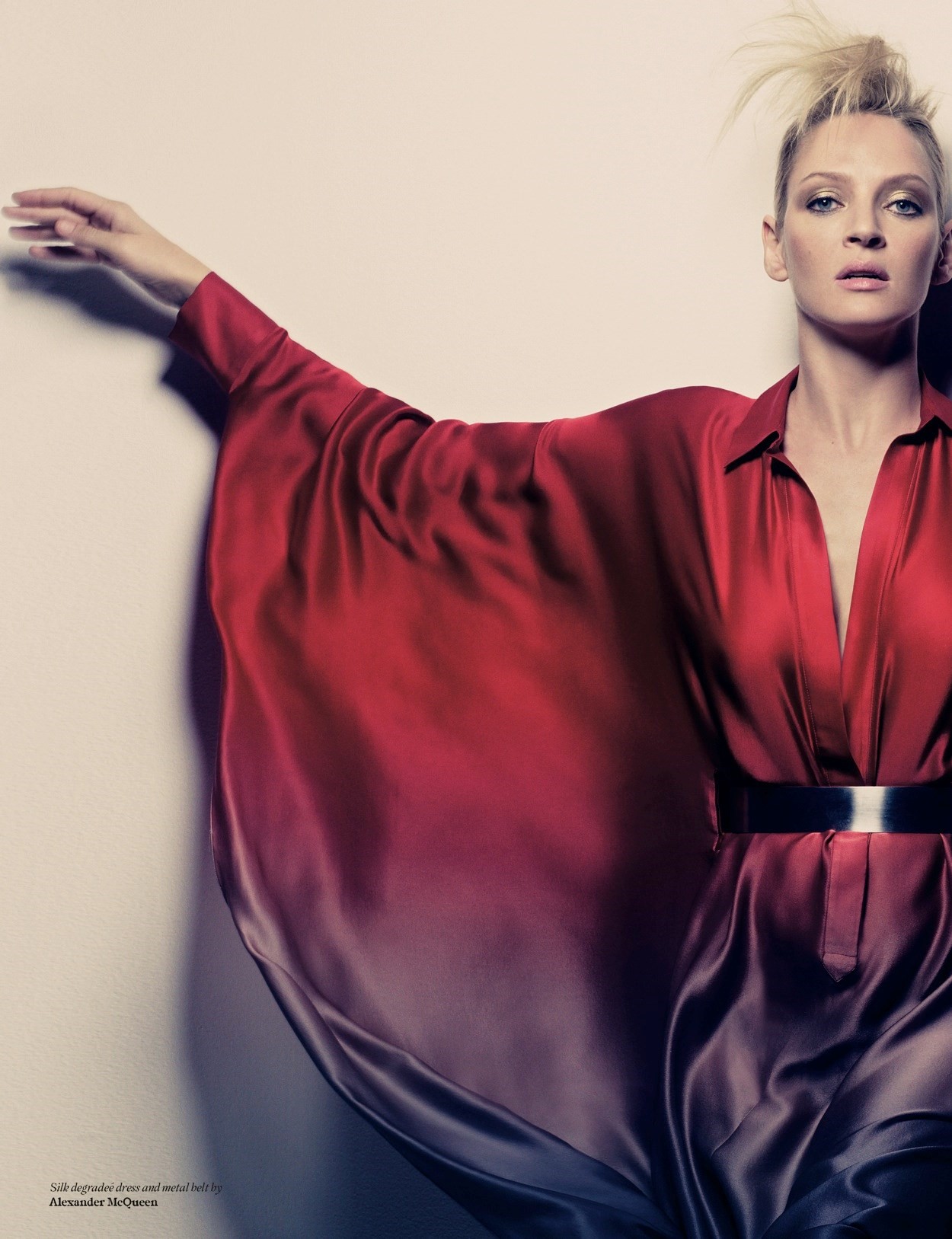
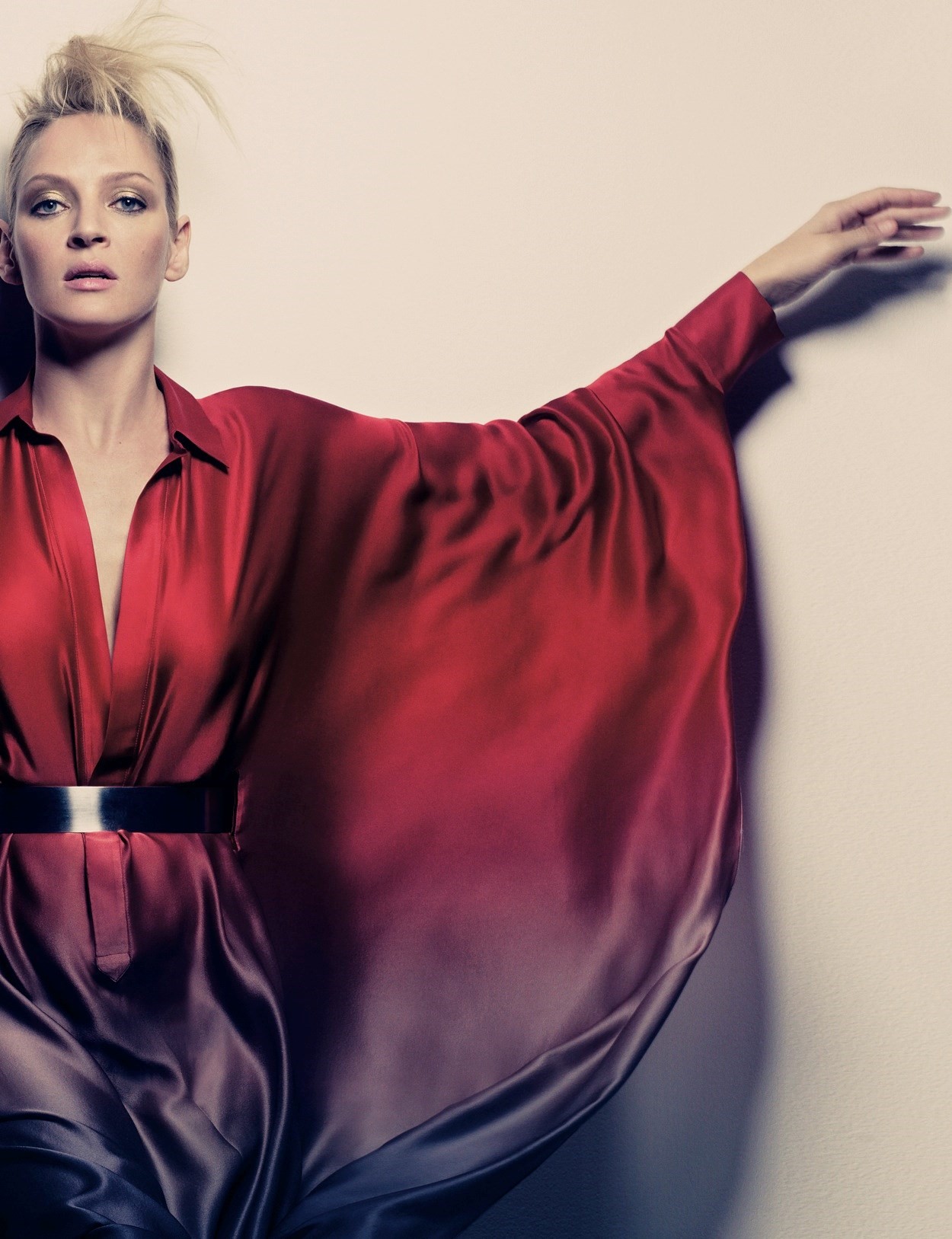
I ask if the film has changed the way men respond to her, but that’s a little too close for comfort. Instead, she describes the reaction of women to Kill Bill. “You know, what I did get for a long time, which I really enjoyed, was how much women needed to hit someone. Because so many would just come up to me and their reactions showed that some part of them was deeply sated by watching a woman hit someone.”
Looking through the list of films in a career stretching over two decades, it’s surprising how little rhyme or reason there is. I mention to Thurman that she has yet to be typecast, Tarantino aside, “And he’s just a director,” she says. “Well he’s not just a director, he’s a great director. But he’s not a genre.” She avoided being pigeon-holed, after Kill Bill, taking roles in the Elmore Leonard-scripted Be Cool and the film adaptation of the Mel Brooks hit musical The Producers, which is the only film her children have seen with her in. “They loved it, I play the big Swedish dingbat.”
“To me, it’s an optimal point of view to see things new and be open-minded and flexible, and yet come at it with an arsenal of experience and humour. There’s not much better to offer than a sense of humour” – Uma Thurman
By awful coincidence the cover story of The New York Times this morning brings conversation round to her latest film, The Life Before Her Eyes. The paper reports yet another killing spree by an American kid, this one in a Nebraskan shopping mall. The details seem too easily concocted to be believed: the 19-year-old gunman had recently broken up with his girlfriend and was sacked from his job at McDonald’s accused of stealing $17. Thurman reaches over for the newspaper. She was living in London at the time of the Dunblane massacre, and a few years ago took part in a gun control campaign in the States, though she says the anti-gun movement feels hopeless. “Life is so fragile. When you think of stories like that. These are stories that happen every day. There are people shot in a mall in the mid-west. And from one moment to the next their entire universe is shattered and changed. There but for the grace ...” The plot of The Life Before Her Eyes, based on Laura Kasischke’s novel of the same name, tells of a Columbine-like high school massacre. Thurman plays a housewife, who as a teenager was faced with an awful Sophie’s Choice life or death decision. The story flashes back to her in school standing with her best friend when a boy with a gun walks in. “Which one of you girls should I kill?” he asks. Years later, as a 40-year-old housewife she delights in her soccermom life. The film is eerie in its hypnotic ordinariness. There is a twist, though, which the book’s reviewers gave away, but that shouldn’t be spoiled.
With a start, Thurman snaps back into gal Uma. Humour, it would seem, is her defence mechanism. Have I noticed the assembled suits lunching around us? “Everyone in this room is in the same three colours. Mostly we’re dealing with grey, black and white. With a tiny bit of tie activity. There’s volatility in the ties. I’d make a great fashion journalist. There’s volatility in the ties today at Lever House.” She is a little hesitant when the subject changes to the time she spent in London in the late 90s, where she met her first husband, actor Gary Oldman (though she says it’s a city she often finds herself in at times of change in her life). She was young when they married, only 20, and they stayed together for a couple of years; as she said later, “Teenage weddings are among the things that don’t count.” But then Thurman had left home at 15 to model her way in to acting, and in Hollywood years pass as quickly as cat years. When she arrived in New York as a teenager, she quickly became street smart, fending off the attentions of men old enough to know better. She came of age on the set of Dangerous Liasons, turning 18 soon into the production. There is a Rolling Stone cover of her then; angelic face and hooded-eyes, heading up a survey of “what’s hot” in 1989. Ageing is not something she fears. “Feeling old is the mentality of the youth,” she says. “You pass a point and everything starts to feel shockingly new again in a way that is absolutely glorious. To me, it’s an optimal point of view to see things new and be open-minded and flexible. And yet come at it with an arsenal of experience and humour. There’s not much better to offer than a sense of humour.”
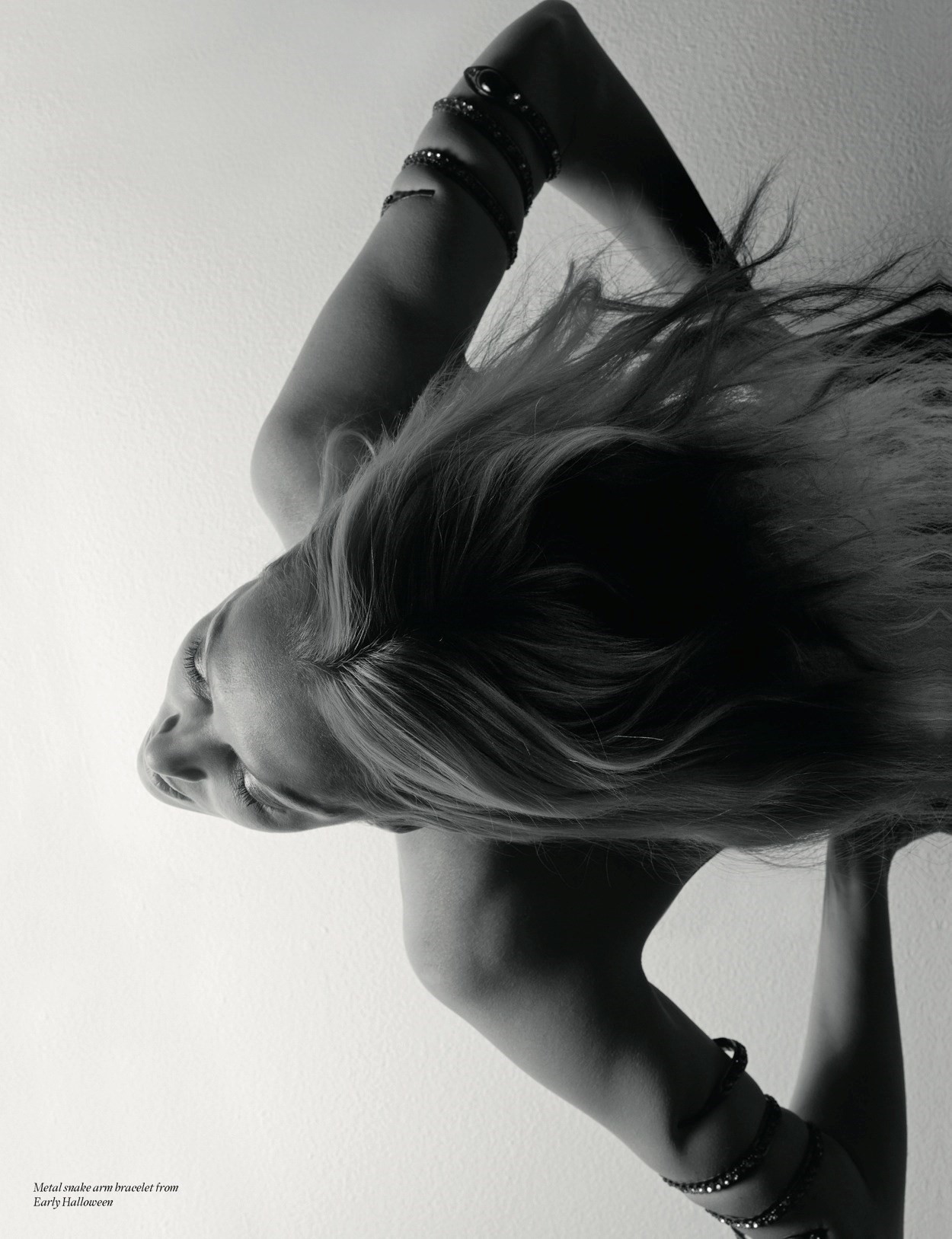
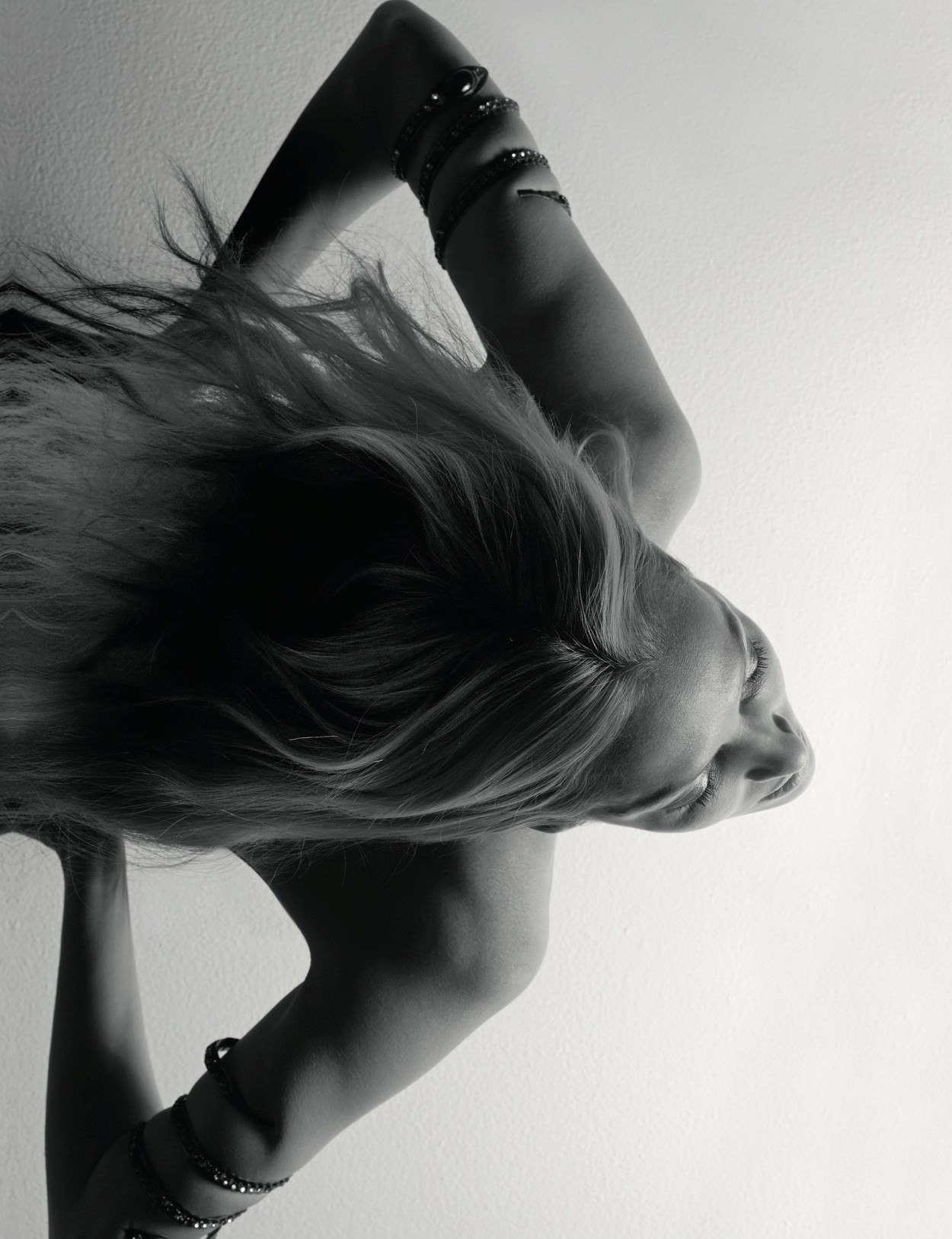
She is refreshingly frank, and funny, about the movies she’s done that didn’t work. Making films, she says, is like a chemistry experiment – “This personality, that personality, this writing, that type of talent. The weather, the drivers.” Her take on it is that if you don’t take risks, you miss out, an attitude that is close to her riskembracing view of fashion. At the 2004 Oscars, her Christian Lacroix dress put her at the top of the year’s worst-dressed list. (Though surely the question that year should have been why on earth she missed out on a nomination for Kill Bill? – perhaps Hollywood doesn’t like its leading ladies this thirsty for blood). Rather sweetly, she has since professed her fondness for the fussy lace Lacroix, saying in its defence that she wore it wrong. Less well remembered is the Prada dress she donned in 1995, the year she was nominated for best supporting actress in Pulp Fiction. It was the first time the label had been seen on the red carpet, and there was a neatness in the pairing. While Tarantino was electrifying cinema-goers with his movies, Miuccia Prada’s label was similarly radicalising fashion. Prada could have been talking for Tarantino when she said, “It’s all about wanting to go forward but still having to deal with nostalgia.” Today, Thurman has been front row at Louis Vuitton for long enough to call the colour of her BlackBerry cover “Hermeès-box orange”. And yet, she says honestly, “I have a very un-precious attitude to fashion.” Being photographed too, she says is a “sideline” – “it’s not really your style. Whether it’s Another Magazine, Vogue or Bazaar. In the same way, you end up playing a part.”
Right now, Uma Thurman is in a good place. She’s sitting out the American writers’ strike, after deciding against a film that she felt was being hurried into production to beat the pickets. “My need to do it is strong. But it’s hard to find the right project” – she corrects herself – “the right movie”. She is spending more time in London again, where her boyfriend, the financier Arpad Busson, is based. The break gives her time to do other things and next week she’s off to Oslo to host the Nobel Prize concert with Kevin Spacey. “When I was 30, I thought I’d done it all. When I was 25, I thought I’d done it all too. It’s amazing how you keep finding more things to do,” she muses. And with that, this charming alpha female pops a chewing gum, steps up and steps out.
Hair: Sam McKnight at Premier, Make-up: Diane Kendal at Art + Commerce, Manicurist: Joanna Czech, Photographic assistants: Chris Ferretti, Huan Nguyen, Styling assistant: Tracey Nicholson, Prop stylist: Stefan Beckman at Exposure, Retouching: The Box Ltd
This story originally appeared in the Spring/Summer 2008 issue of AnOther Magazine.
